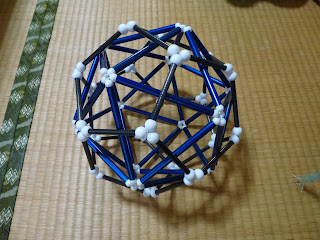He demonstrated in front of us that dodecahedron and icosahedron are dual to each other using this kind of models. With long cylindrical tubes, the whole structure becomes very flexible, so you can compress it and put one inside the other. Students can realize, through this amazing way, why dodecahedron and icosahedron are dual to each other. I can only say that Mr. Horibe must be a very effective math teacher. I wish I could learn math from him when I was a high school student.



In some sense, this kind of bead models is very similar to the so-called tensegrity structures. BTW, Mr. Horibe usually uses a single elastic string for making his bead models, which makes his models even more flexible and bendable. I will comment more on this aspect later.
No comments:
Post a Comment